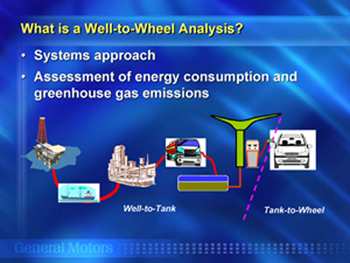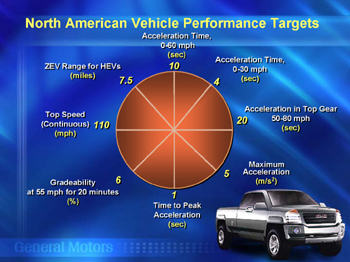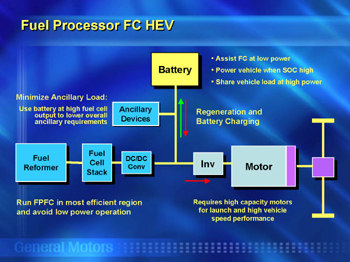Well to Wheel: Gauging Total Energy and
Emissions for Advanced Technologies
One of the figures that consumers give
special consideration to when they're looking for a new vehicle
is the fuel efficiency. The EPA city and highway fuel economy
numbers give them a pretty good idea of how vehicles compare
on a per-mile basis. That's important, especially now that
an ever-expanding range of fuel and propulsion systems offer
consumers more options than ever.
But the energy used by the vehicle per unit of distance
traveled tells only part of the story. Even consumers who
wouldn't describe themselves as "green" express
concern about vehicle emissions. Although an electric or
fuel cell vehicle seems to provide an answer, producing
the electricity or hydrogen to fuel these vehicles also
has a cost in terms of energy consumption and greenhouse
gas emissions. Unfortunately, the sticker on the window
of a showroom car doesn't list any of these figures.
To provide information on the big picture, GM conducted
a "Well-to-Wheel Study" for both North America
and Europe. The studies analyzed energy use and greenhouse
gas emissions for combinations of advanced fuel and propulsion
systems on a total system basis: from well to tank - the
production source of energy - and from tank to wheel - the
vehicle itself (see Figure 1).

Figure 1. Both Well-to-Wheel studies used a
systems approach to analyze energy consumption and greenhouse
gas emissions for combinations of advanced fuel and propulsion
systems from well to tank (the energy production source)
and from tank to wheel (the vehicle itself). (Click
to enlarge)
"We designed the study to help inform public and private
decision makers about the impact of introducing advanced
fuel and propulsion systems," says Norm Brinkman, Group
Manager for Fuel Chemistry and Systems in the GM R&D
Chemical and Environmental Sciences Laboratory. "These
choices shouldn't be made based only on what occurs on-board
the vehicle; rather, the whole energy and emissions cycle
needs to be considered."
Predicting the future
To conduct the well-to-tank analysis, GM partnered with
Argonne National Laboratories in North America and Ludwig
Bölkow Systemtechnik in Europe, along with oil companies
BP, Exxon Mobil, Shell, and Total Fina Elf. The tank-to-wheel
analysis was performed entirely by GM, using a Chevrolet
Silverado full-sized pickup for the North American study
and an Opel Zafira minivan for the European.
"Our goal was to predict energy consumption and greenhouse
gas emissions for vehicles in 2010," explains Trudy
Weber, Staff Research Scientist. "We therefore needed
to project how the various technologies would evolve in
order to evaluate them consistently. We were looking at
propulsion-fuel system combinations as diverse as conventional
drives with gasoline engines, diesel hybrids, and on-board
fuel-processor fuel cell vehicles."
Regardless of the technology, all vehicles were required
to deliver the same performance based on parameters such
as acceleration, top speed, and vehicle range (see Figure
2). "Often people relax some of these performance requirements,
which makes the fuel economy gains greater than they otherwise
would be," says Weber. "We maintained the vehicle
performance by sizing the propulsion system appropriately
and then calculating the fuel consumption and emissions
output."

Figure 2. The performance targets served as
the design criteria for North American vehicle concepts.
Researchers optimized powertrain operation based on EPA
driving cycles by using energy management and control strategies
to achieve the maximum fuel economy for each vehicle concept.
To provide more realistic and realizable fuel economy projections,
they imposed constraints on component operation (e.g., engine,
accessories, motors, batteries) to reflect vehicle driveability
and comfort requirements. (Click to enlarge)
To obtain the information necessary to run the simulations
and perform the analysis for the North American study, Weber
worked with many different groups at GM responsible for
advanced propulsion technologies (see Figure 3 for an example).
She reviewed the results of the analysis and simulation
work with the technology owners to ensure that it properly
represented the technology's potential. Later, the entire
process was repeated for Europe based on their future technology
options.

Figure 3. A schematic illustrating the Fuel
Processor Fuel Cell Hybrid Electric Vehicle shows the complexity
of the systems that were simulated to determine energy efficiency
for the tank-to-wheel portion of the study. (Click to
enlarge.)
Why run the study again? The source and processing of fuels
in Europe are quite different from those in North America.
Europeans drive significantly fewer trucks, but the minivan
enjoys a high popularity. In addition, performance requirements,
which impact the size of the powertrain, vary between the
two continents, as do the driving cycles mandated by regulatory
agencies.
For the extensive effort that went into gathering the information
required, coordinating with GM and Opel advanced technology
groups, performing the simulations and analyses, and reporting
the results, the Well-to-Wheel Study received GM R&D's
McCuen Award in 2001.
The Bottom Line
In the end, the results reflecting the technology trends
did not differ greatly between the North American and European
studies - but they did make clear the larger impacts of
introducing advanced propulsion and fuel systems.
From well to tank
In terms of total energy use, petroleum-based fuels and
compressed natural gas produced the lowest well-to-tank
energy losses. Fuels with the highest losses included liquid
hydrogen, produced from central plants, hydrogen produced
via electrolysis, electricity, and cellulosic ethanol.
With regard to greenhouse gases, producing petroleum-based
fuels and natural-gas based methanol resulted in fewer well-to-tank
emissions than producing electricity or hydrogen from fossil
fuels. Producing hydrogen from natural gas results in high
greenhouse gas emissions, because it requires removing all
the carbon in the natural gas feedstock. In contrast, greenhouse
gas emissions for ethanol pathways could be negative, because
plants, trees, and grass use up different amounts of carbon
as they grow.
From tank to wheel
As a baseline, the researchers used a conventional automatic
transmission driven by a gasoline engine; they then compared
energy consumption for the advanced powertrain concepts
to determine the improvement. The simulations included diesel,
ethanol, compressed natural gas, methanol, and hydrogen
in corresponding internal combustion engines and fuel cell
systems, plus conventional drives using state-of-the-art
mechanical transmissions and hybrid electric drives. All
systems had to meet the appropriate emissions standards,
whether U.S. or European, that will be in place in 2010.
In terms of fuel consumption, diesel engines showed improvements
over conventional technology and fuel cell systems proved
even better. To provide even greater reductions, either
diesel or fuel cell technology can be incorporated into
a hybrid propulsion system.
Putting it all together
Overall the diesel hybrid and fuel cell vehicles used the
lowest amount of total system energy. The diesel hybrid
also offered a significant reduction in greenhouse gas emissions
compared to the conventional gasoline engine. Ethanol-fueled
vehicles yielded the lowest greenhouse gas emissions, followed
by fuel cell hybrids. The fuel cell, however, did not result
in as large a benefit as some expected.
"Running fuel cell vehicles doesn't produce greenhouse
gases, but producing the hydrogen does, especially if it's
made from natural gas," says Brinkman. "Even so,
the fuel cell vehicle emits fewer greenhouse gases than
the best petroleum technologies - but to really decrease
these emissions, the hydrogen should be made from a renewable
resource, such as wind energy. Unfortunately, cost and lack
of availability makes that impractical within the next 10
years."
In the end, what became obvious to Brinkman is the potential
for improvement - and the need for creative solutions. To
provide further information on new propulsion and fuel technologies,
a study to estimate criteria pollutants (hydrocarbons, carbon
monoxide, nitrogen oxides, and particulate matter) for the
United States will be released in 2003.
Links
Both Well-to-Wheel studies are available online:
North American Well-to-Wheel Study
European Well-to-Wheel Study.





